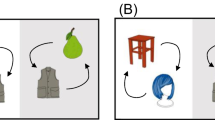Abstract
Subjects produced subject-verb sentences of prespecified structure, such asThe man is kicking, in response to pictures. The amount of information required to identify the pictured actor or action and to retrieve a name for the actor was varied. The following results, based on subject response latencies, were obtained. Experiment I demonstrated that only some initial amount of verb information processing occurs before and delays the initiation of such subject-verb sentences. Experiment II demonstrated that verb information processing is initiated only after the subject of the sentence has been identified. Finally, Experiment III demonstrated that verb information processing is initiated in parallel with the retrieval of the name for the subject of the sentence.
Similar content being viewed by others
References
Boomer, D. S. (1965). Hesitation and grammatical encoding.Language Speech 8:148–158.
Brain, R. (1961). The neurology of language.Brain 84:145–166.
Brown, R., and McNeill, D. (1966). The “tip of the tongue” phenomenon.J. Verb. Learn. Verb. Behav. 5:325–337.
Crossman, E. R. F. W. (1953). Entropy and choice time: The effect of frequency unbalance on choice responses.Quart. J. Exp. Psychol. 5:41–51.
Fraisse, P. (1964). Le temps de reaction verbale. I. Denomination et lecture.Ann. Psychol. 64:21–46.
Fraisse, P. (1969). Why is naming longer than reading?Acta Psychol. 30:96–103.
Goldman-Eisler, F. G. (1968).Psycholinguistics: Experiments in Spontaneous Speech, Academic Press, New York.
Hick, W. E. (1952). On the rate of gain of information.Quart. J. Exp. Psychol. 4:11–26.
Hyman, R. (1953). Stimulus information as a determinant of RT.J. Exp. Psychol. 45:188–196.
Lenneberg, E. H. (1967).Biological Foundations of Language, Wiley, New York.
Lindsay, R. K., and Lindsay, J. M. (1966). Reaction time and serial versus parallel information processing.J. Exp. Psychol. 71:294–303.
Lindsley, J. R. (1975). Producing simple utterances: How far ahead do we plan?Cogn. Psychol. 7:1–19.
MacKay, D. G. (1970a). Context-dependent stuttering.Kybernetik 7:1–9.
MacKay, D. G. (1970b). Spoonerisms: The structure of errors in the serial order of speech.Neuropsychologia 8:323–350.
Maclay, H., and Osgood, C. E. (1959). Hesitation phenomena in spontaneous English speech.Word 15:19–44.
Martin, J. G., and Strange, W. (1968). The perception of hesitation in spontaneous speech.Percept. Psychophys. 3:427–438.
Mowbray, G. H. (1960). Choice reaction time for skilled response.Quart. J. Exp. Psychol. 12:193–202.
Neisser, U. (1967).Cognitive Psychology, Appleton-Century-Crofts, New York.
Oldfield, R. C. (1966). Things, words, and the brain.Quart. J. Exp. Psychol. 18:340–353.
Olson, D. R. (1970). Language and thought: Aspects of a cognitive theory of semantics.Psychol. Rev. 77:257–273.
Osgood, C. E. (1963). On understanding and creating sentences.Am. Psychologist 18:735–751.
Rubenstein, H., Lewis, S. S., and Rubenstein, M. A. (1971). Homographic entries in the internal lexicon: Effects of systematicity and relative frequency of meanings.J. Verb. Learn. Verb. Behav. 10:57–62.
Southworth, F. C. (1967). A model of semantic structure.Language 43:342–361.
Tannenbaum, P. H., Williams, F., and Hillier, C. S. (1965). Word predictability in the environments of hesitations.J. Verb. Learn. Verb. Behav. 4:134–140.
Thorndike, E. L., and Lorge, I. (1944).The Teacher's Wordbook of 30,000 Words, Teacher's College, Columbia University, New York.
Wingfield, A. (1968). Effects of frequency on identification and naming of objects.Am. J. Psychol. 81:226–234.
Author information
Authors and Affiliations
Additional information
This article is based on a Ph.D. dissertation submitted to New York University.
Rights and permissions
About this article
Cite this article
Lindsley, J.R. Producing simple utterances: Details of the planning process. J Psycholinguist Res 5, 331–354 (1976). https://doi.org/10.1007/BF01079933
Received:
Issue Date:
DOI: https://doi.org/10.1007/BF01079933




